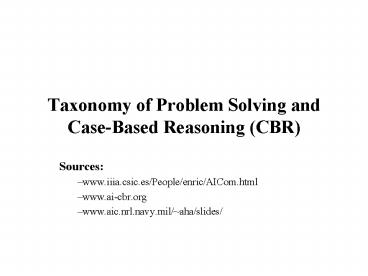Taxonomy of Problem Solving and Case-Based Reasoning (CBR) PowerPoint PPT Presentation
Title: Taxonomy of Problem Solving and Case-Based Reasoning (CBR)
1
Taxonomy of Problem Solving and Case-Based
Reasoning (CBR)
- Sources
- www.iiia.csic.es/People/enric/AICom.html
- www.ai-cbr.org
- www.aic.nrl.navy.mil/aha/slides/
2
Taxonomy of Problem Solving
- Synthesis
- constructing a solution
- Methods planning, configuration
- Analysis
- interpreting a solution
- Methods classification, diagnosis
3
Classification Tasks
- Properties
- Problem domain consists of two disjoint sets of
domain objects - A set of Observations, S
- A set of Classes, C
- Problem description, P set of observations
(subset of S) - Solution, c a class (an element of C)
- A collection of problem descriptions P
- A classifier is a function
Restaurant example
class P ? C
4
Classification Approximation
- Classification Approximation
- Input A collection of pairs problem-solution
(P1,c1), (P2,c2), , (Pn,cn). These pairs are a
subset of an unknown classifier class P ? C - Output a hypothesis classifier H such that
- For each Pi, H(Pi) class(Pi)
- H is close to class for other P in P
5
Diagnosis
- Diagnosis is a generalization of a classification
problem in which not all observations are known
in advance - As part of the diagnosis process all the relevant
observations are determined - Example
- Help-desk operators query the customer about the
malfunctions in the service/product
- case-based reasoning (CBR) can be used for
diagnosis tasks
6
CBR Definition
A problem-solving methodology where solutions to
similar, previous problems are reused to solve
new problems.
7
Problem-Solving with CBR
CBR(problem) solution
Problem Space
p3
p2
p1
Solution Space
s4
s3
s1
s2
8
CBR First Example
Example Slide Creation
- 9/1/06 talk_at_ cse335
9
Some Interrelations between Topics
- Retrieval
- Information gain
- Similarity metrics
- Indexing
- Reuse
- Rule-based systems
- Revise Review
- Constraint-satisfaction systems
- Retain
- Induction of decision trees
10
CBR Outstanding Issues
1. Sometimes natural (e.g., law, diagnosis)
- 2. Cases simplify knowledge acquisition
- Easier to obtain than rules
- Captures/shares peoples experiences
- 3. Good for some types of tasks
- When perfect models are not available
- Dynamic physical systems
- Legal reasoning
- When small disjuncts are prevalent
- Language learning
- 4. Commercial application
- Help-desk systems (e.g., Inference corp. 700
clients) - e-commerce (e.g., Analog Device)
11
CBR History
- 1982-1993 Roger Schanks group, initially at
Yale - Modeling cognitive problem solving (Kolodner,
1993) - New topics Case adaptation, argument analysis,
- 1993 European emergence (EWCBR93)
- Expert systems, empirical/application focus
1993-1998 INRECA ESPRIT projects
- 1995 First international conference (ICCBR95)
- Knowledge containers (M. Richter)
- First IJCAI Best Paper Award (Smyth Keane
Competence models)
1997- Textual CBR (Lenz, Ashley, others)
1997- Knowledge management
1997- Case-based maintenance
1999- e-Commerce
2003- Readings in CBR
2005- I chaired ICCBR-05
12
Taxonomy of Problem Solving and CBR
Use CBR?
- Synthesis
- constructing a solution
- Methods planning, configuration
- Analysis
- interpreting a solution
- Methods classification, diagnosis

